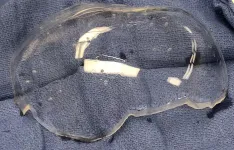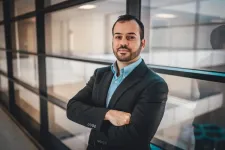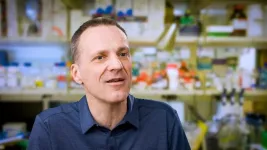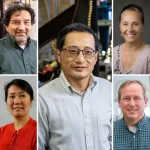(Press-News.org) A new type of immunotherapy, developed by UCL researchers, has shown promising preclinical results against a bone cancer called osteosarcoma, as part of a study in mice.
Osteosarcoma is the most common bone cancer in teenagers but is still relatively rare, with around 160 new cases each year in the UK. Meanwhile, more than 150,000 people suffer from cancer that has spread to the bones.
Cancer that starts in or spreads to the bones is particularly hard to treat, meaning that it is a leading cause of cancer-related death. It is also frequently resistant to chemotherapy, so new treatments are needed.
The results of the experiment, published in Science Translational Medicine, found that using a small subset of immune cells, called gamma-delta T cells (gdT cells) could provide an efficient and cost-effective solution.
gdT cells are a less well-known type of immune cell that can be made from healthy donor immune cells. They have strong innate anti-cancer properties, can kill antibody labelled targets and can safely be given from one person to another, without the risk of graft-versus-host disease.
In order to manufacture the cells, blood is taken from a healthy donor. The gdT cells are then engineered to release tumour targeting antibodies and immune stimulating chemicals called cytokines, before being injected into the patient with cancer in the bone. This new treatment delivery platform is called OPS-gdT.
The researchers tested the treatment on mouse models with bone cancer and found that OPS-gdT cells outperformed conventional immunotherapy when controlling osteosarcoma growth.
Lead author, Dr Jonathan Fisher (UCL Great Ormond Street Institute of Child Health and UCLH), said: “Current immunotherapies such as CAR-T cells (another type of immunotherapy using genetically modified immune cells) use the patient’s own immune cells and engineer them to improve their cancer-killing properties. However, this is expensive and takes time, during which a patient’s disease can get worse. And, while it is an effective treatment for leukaemia it has been found to be less effective against solid cancers.
“An alternative is to use an ‘off the shelf’ treatment made from healthy donor immune cells, but in order to do this care must be taken to avoid graft-versus-host disease, where the donor immune cells attack the patient’s body.
“The Fisher Lab discovered a way of engineering the previously under-utilised gdT cells, which have been clinically proven to be safe when made from unrelated donor blood. This offers a more cost-effective alternative to current per-patient manufacturing.”
As part of the trial, researchers injected the mice with gdT cells that hadn’t been engineered at all, an anti-tumour antibody, OPS-gdT cells alongside a bone sensitising drug, and CAR T-cells.
They found that the OPS-gdT cells were most effective when partnered with the bone sensitising drug – which has previously been used on its own to strengthen weak bones in patients with cancer. This treatment prevented the tumours from growing in the mice that received it – leaving them healthy three months later.
Dr Fisher said: “Thousands upon thousands of people have cancer that spreads to the bones. There is currently very little that can be done to cure these patients. However, this is an exciting step forward in finding a potential new treatment.
“Our hope is that not only will this treatment work for osteosarcoma but also other adult cancers.”
Following the successful preclinical trial, the team is now generating data on the effectiveness of OPS-gdT cells in secondary bone cancers and plan to move towards an early phase clinical trial using patients with secondary cancers within the next couple of years.
This work was supported by UCLB, the innovation commercialisation operation for UCL. Sara Garcia Gomez, Senior Business Manager at UCLB, said: “We work closely with clinicians at the forefront of research to help them bring new treatments from the lab to the patient. With few treatment options out there for bone cancers, this study has shown encouraging potential for new therapies. We will continue to work closely Dr Fisher and his team through the next important stages of exploring the potential of this new approach.”
The research was also supported by UCL Technology Fund and the National Institute for Health and Care Research GOSH Biomedical Research Centre (NIHR GOSH BRC). It also received support from Professor Katia Scotlandi (Rizzoli Orthopaedic Institute, Bologna), the Children’s Cancer and Leukaemia Group and the Little Princess Trust.
Tanel Ozdemir, Investor, UCL Technology Fund said: “We’ve had the pleasure of working with Dr Fisher and his talented team at UCL for a number of years now. We believe the OPS-gdT platform demonstrates a significant leap in how effectively apply immunotherapies to treat solid tumours. We’re extremely excited by the potential of technology and look forward to continuing our support of Dr Fisher as he tries to bring this treatment to patients.”
END
In the first study of its kind, researchers from the Keck School of Medicine of USC and the California Institute of Technology (Caltech) designed and implanted a transparent window in the skull of a patient, then used functional ultrasound imaging (fUSI) to collect high-resolution brain imaging data through the window. Their preliminary findings suggest that this sensitive, non-invasive approach could open new avenues for patient monitoring and clinical research, as well as broader studies of how the brain functions.
“This is the first time anyone had applied ...
HOUSTON, May 29, 2024 – Mim Rahimi, an assistant professor of civil and environmental engineering at the University of Houston, has received a National Science Foundation CAREER award for his research proposal focusing on liquid-liquid interfaces for electrochemical carbon capture research.
His research proposal is “Leveraging Liquid-Liquid Interfaces for Innovative Electrochemical Carbon Capture.” It was selected for $537,719 in funding, with research running through August 2029.
“The project ...
An analysis of civilian injuries resulting from interactions with police in Illinois found that residents of all races and ethnicities are more likely to sustain injuries if they live in economically under-resourced areas. The risk of injury decreases as communities become more racially diverse, the researchers found.
The study from the University of Illinois Chicago analyzed information on nearly 5,000 injuries caused by police that were treated in Illinois hospitals between 2016 and 2022. The researchers then compared that information with socioeconomic data from the U.S. Census on each injured person’s home ZIP code. The study is published in the ...
According to the U.S. Centers for Disease Control and Prevention, 80% of those living with dementia receive informal care from family members or friends. This equates to 16 million family caregivers in the U.S. However, caring for family members with dementia is often associated with increased caregiver burden (which includes emotional, physical, and financial strain), stress, and worse physical health for the caregiver.
A recent study published in the Journal of Applied Gerontology, led by George Mason University researchers, found that a 9-week online stress ...
Sticks and stones aren’t enough to thwart biological attraction, but sometimes those are the only tools available to pastoralists trying to prevent wildlife from eloping with their livestock.
A new study led by Colorado State University brings awareness to both the human impacts of these encounters – ranging from economic loss to death – and conservation concerns for the wild animals that are often endangered.
Conserving threatened and endangered species is a globally recognized priority, but justice and equity for the marginalized pastoralist populations around the world who experience conflict with these species are often ...
Leaders from the Mass General Cancer Center, a member of the Mass General Brigham healthcare system, will present research discoveries and outcomes from clinical trials in cancer at the 2024 American Society of Clinical Oncology (ASCO) Annual Meeting, held May 31-June 4, in Chicago.
ASCO brings together leading experts in clinical oncology to share the latest breakthroughs in cancer research, science and medicine. Presentations from Mass General Cancer Center investigators include a plenary session on palliative care delivery via telehealth versus in-person for patients with advanced lung cancer. Oral presentations ...
NEWPORT NEWS, VA – Physicist Holly Szumila-Vance has always been curious about how the world works. Throughout her career, she has never been afraid to tackle new and tough challenges to satisfy that curiosity. In doing so, she has helped reveal new details of how the ubiquitous proton interacts with the strong force inside matter.
Now, her work to reveal the nature of matter at the U.S. Department of Energy's Thomas Jefferson National Accelerator Facility has just won special recognition: the prestigious 2024 Guido Altarelli Award – Experimental ...
SEATTLE — May 29, 2024 — Foam mixed with medications is already used to treat conditions such as varicose veins, hemorrhoids, wounds on the skin and even hair loss. Now, Fred Hutch Cancer Center scientists have found that foam might also be used as a vehicle to deliver expensive gene therapies.
Published May 28 in Nature Communications, bioengineer Matthias Stephan, MD, PhD, and his Fred Hutch team report that a foaming liquid worked better than a standard liquid formulation at transferring gene therapy components to cells in laboratory studies.
“Gene therapies are the new wave of medicine, but they are extremely ...
The waste generated by power generation utility companies could be a potential source of metals and minerals that are key components of modern electronics, batteries, vehicles, and the clean-energy industry as a whole.
Zheng Yao, principal research scientist within Lehigh University’s Energy Research Center (ERC), and a multidisciplinary team of researchers recently received a $2.5 million grant from the Department of Energy (DOE) to identify rare earth elements (REEs) and elements of interest (EOIs) in wastewater and solid waste streams, and to develop the technology that could extract those elements.
The project team includes ...
Darío Gil, Ph.D., IBM Senior Vice President and Director of Research and a member of the Board of Trustees for Rensselaer Polytechnic Institute (RPI), has been elected chair of the National Science Board (NSB).
The NSB is the governing board of the National Science Foundation (NSF) and adviser to Congress and the President on policy matters related to STEM research and STEM education.
“Darío Gil’s insights and innovative thinking will be indispensable to his leadership of the NSB,” said RPI President Martin A. Schmidt, Ph.D. “His election speaks volumes about his exceptional talents ...





